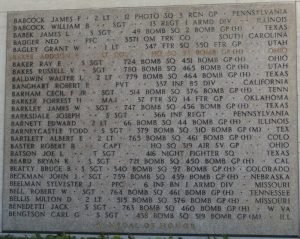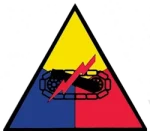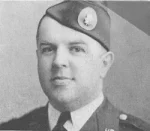Sgt. William Brown Babcock was born on September 5, 1918, to William H. Babcock and Bird Brown-Babcock in Alameda, California. He had three brothers and a sister. One brother died in 1936. The family moved to Maywood, Illinois, and lived at 615 North Eighth Avenue. He attended Lincoln School, Emerson School, and Proviso Township High School for one year. He then worked as a gas station attendant. When the Selective Service Act took became law, he registered for the draft on October 16, 1940, and named his father as his contact person.
He was inducted into the US Army on April 16, 1941, and did his basic training at Fort Knox, Kentucky, and issued the Serial Number 36, 025, 789. His basic training was relatively short. In June 1941, he was sent to Camp Polk, Louisiana. It is known that the 753rd Tank Battalion was being formed at Camp Polk at the time so he may have been assigned to the battalion. He hospitalized at Camp Polk from October 4th to 31st, but it is not known why he was hospitalized. After this he was transferred back to Ft. Knox. He remained at Ft Knox until May 1942. During this time he was assigned to Company D, 13th Armor Regiment, 1st Armor Division, and rose to the rank of sergeant and tank commander.
What is known is that the 1st Armor Division was sent to Ireland and then England where they were reviewed by the King and Queen of England. From England they were sent to North Africa and were one of the first units to land in Oran, North Africa. His unit took part in the Battle of Kasserine Pass (actual name Faid Pass) from February 18, 1943 to February 23, 1943, in Tunisia. His unit held its position so that the main part of the division could withdraw and reform. They appeared to have remained in North Africa until they were sent to Italy to take part in the Battle of Anzio, where he took part in 12 major engagements.
Records show he was in the 9th Evacuation Hospital on May 23, 1943, at the 38th Evac. Hospital on May 26th, and the 35th Evac. Hosp. on May 31st. He was also in the 8th Evac. Hospital from February 10, 1944 until February 24, 1944. During this time, he was never wounded, but he was hospitalized for appendicitis and an infected insect bite.
In a letter home that his parents received on May 28, 1944, he wrote, “I’m very tired and very busy ……… if you only knew how.” The 13th Armor Regiment on May 29, 1944, was attacking northwestward along the Campoleone Station. Much of the battle was in an area described as civilian cemeteries. In an after action report it was stated.
“Out tanks also harassed by close-range infantry opposition, suffered severely during the afternoon. By evening 21 M-4s and 16 M5s had been knocked out. In contrast with the the initial attacks above Ciaterna, where damage was due largely to mines and was easily to reparable, most of the casualties on 29 May were caused by anti tank guns and resulted in complete losses. For the night the 3rd Battalion, 1st Armor Regiment, pulled back two miles to the line of the infantry, a mile north of Campoleone Station. Through the attack had only been partially successful, Campoleone was now firmly in our hands.
“During the night, the 1st Battalion, 6th Armor Infantry, was attached to Combat Command B. The 2nd Battalion, 135th Infantry, and the 2nd Battalion, 1st Armor Regiment, reinforced Combat Command A and moved out with the 2nd Battalion, 6th Armor Infantry, on the morning of the 30 May. The infantry had to fight its way to the line of departure, while the tanks could move forward only about 1000 yards. A second attack in the Combat Command A zone in the afternoon merely produced further losses, for the enemy laid heavy fire from antitank guns, tanks, and self-propelled guns on any of our tanks that moved. In addition, he launched several counter-attacks of tanks and infantry…….”
It was during this action that William was reported to have been Killed in Action on May 30, 1944, when his tank was hit by enemy fire near Capdellesterinccis, Italy. The bodies of two identified American soldiers and three unidentified American soldiers were recovered after the battle. William’s parents received a telegram from the War Department.
MRS BIRD BABCOCK
615 NORTH 8TH AVENUE
MAYWOOD ILLINOIS
THE SECRETARY OF WAR DESIRES ME TO EXPRESS HIS DEEP REGRET THAT YOUR SON SERGEANT WILLIAM B BABCOCK HAS BEEN REPORTED MISSING IN ACTION SINCE THIRTY MAY IN ITALY PERIOD IF FURTHER DETAILS OR OTHER INFORMATION ARE RECEIVED YOU WILL BE PROMPTLY NOTIED PERIOD
ULIO
THE ADJUTANT GENERAL
William’s death was not confirmed by the War Department until September 1, 1944. This appears to have been the last communication his parents had with the War Department until they were informed his brother, Arthur, was missing in action in December 1944.
After the war, the remains of American soldiers were being found by Italian civilians who were working their fields. One farmer, on July 27th, found the remains of an American. He knew it was an American by the remains of the clothing he was wearing. It appears additional remains of Americans were found at this time. On November 29, 1947, Italian civilians found the remains of an American soldier on what was called the Ferranti Luigi Farm which were recovered by an American Graves Registration team on December 11th.
On April 14, 1948, William’s father wrote a letter to the Quartermaster General stating that his wife and he had never received any information on the recovery of William’s remains or where he was buried. It is not known if his father ever received a response to the letter. In a letter dated July 26, 1948, his father was informed by the Quartermaster Corps that William’s remains had not been recovered. He did receive a letter from the Quartermaster Corps dated July 13, 1949.
Mr. William Babcock
615 North 8th Avenue
Maywood, Illinois
Dear Mr. Babcock:
Almost four years have elapsed since the cessation of hostilities of World War II, which cost the life of you son, the late Sergeant William B. Babcock.
The unfortunate circumstance surrounding his death have been thoroughly reviewed and, based on information presently available, the Department of the has been forced to determine that his remains are not recoverable. I wish to assure you that, should any additional evidence come to our attention indicating that his remains are in our possession, you will be informed immediately.
Realizing the extent of your grief and anxiety, it is not easy to express condolences to you who gave loved one under circumstances so difficult that there is no grave at which to pay homage. May the knowledge of his honorable service to his country be a source of sustaining comfort to you.
Sincerely yours,
(signed)
W. E. CAMPBELL
Lt. Colonel, QMC
Memorial Division








